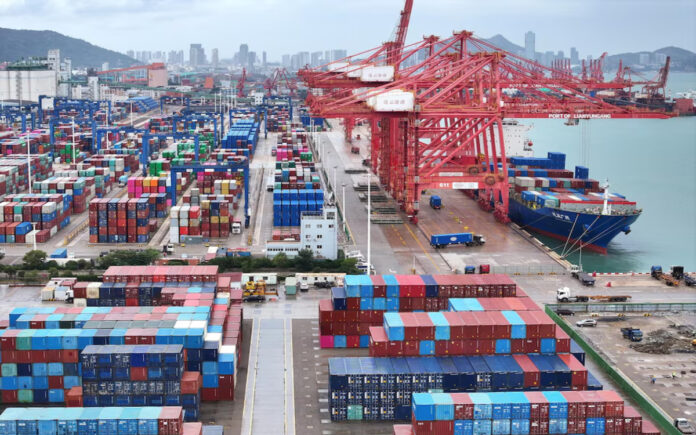Beijing: China’s exports surged at the fastest pace in over two years in October, driven by factories rushing to stockpile goods in anticipation of potential tariffs from the U.S. and the European Union. The increased momentum comes as the looming threat of a two-front trade war with both major economies intensifies, particularly with the election of Donald Trump as U.S. president. His pre-election promise to impose tariffs on Chinese imports exceeding 60% has sent shockwaves through Chinese industries, prompting a rush to send goods to key export markets.
With about $500 billion worth of shipments annually at stake, factory owners and officials are scrambling to mitigate the impact of Trump’s proposed tariffs, as well as escalating trade tensions with the European Union, which imported $466 billion in Chinese goods last year. This spike in exports offers some relief to China’s economy, which has been hit hard by a prolonged property market debt crisis that has dented both household and business confidence.
According to customs data released Thursday, outbound shipments from China grew by 12.7% year-on-year in October, far exceeding the 5.2% growth forecast in a Reuters poll of economists and the 2.4% rise recorded in September. In contrast, imports fell by 2.3%, marking the first negative reading in four months and signaling waning domestic demand.
Xu Tianchen, a senior economist at the Economist Intelligence Unit, noted that the export boom could be driven by “front-loading” ahead of anticipated pressures in 2025. “We can anticipate a lot of front-loading going into the fourth quarter before the pressure kicks in come 2025,” he said, pointing to the looming tariff threat from Trump. The U.S. saw a year-on-year increase of 8.1% in Chinese exports, while shipments to Europe rose by 12.7%.
Zichun Huang, a China economist at Capital Economics, projected continued strong shipments in the coming months but cautioned that the full impact of Trump’s tariffs may not be felt until the latter half of next year. “Trump’s return could create a short-term boost to Chinese exports as U.S. importers increase their purchases to get ahead of the tariffs,” Huang added.
Also Read | 2024 Poised to Break Global Heat Records, EU Climate Scientists Warn
Despite the export surge, trade data from other regions, such as South Korea and Taiwan, points to cooling global demand, with analysts suggesting that Chinese producers may be slashing prices to maintain sales or simply moving inventory out of China. A factory activity survey for October revealed that Chinese factories continue to face challenges in securing overseas buyers, highlighting the possibility that October’s export growth may be driven more by an inventory shift rather than genuine demand.
Additionally, the favorable weather helped Chinese exporters catch up on delayed orders caused by earlier disruptions. Typhoon Bebinca had halted Shanghai’s operations for a day in September, while a violent tornado in Jiangsu province and other extreme weather events had further impacted production. These natural disasters cost China an estimated 230 billion yuan ($32.23 billion) in direct economic losses over the third quarter.
Also Read | Half of Japanese Firms Aim for 3% Wage Hike in 2025, Survey Finds
While the surge in exports provides a temporary boost, economists caution against relying too heavily on outbound shipments for economic growth. Experts are now focusing on a $1.4 trillion fiscal package that the Chinese government is expected to approve this week. This package is anticipated to stabilize local government finances and support property developers, helping to alleviate the pressures on consumption.
China’s trade surplus for October stood at $95.27 billion, up from $81.71 billion in September, as strong exports helped offset the downturn in imports.



